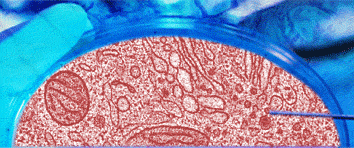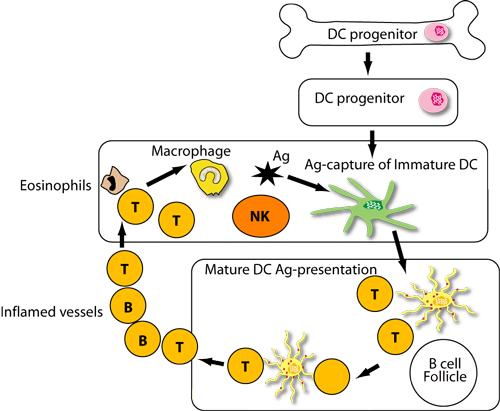 |
 |
 |
Dendritic CellsWhat are Dendritic CellsDendritic cells (DCs) are immune cells and form part of the immune system. Their main function is to process antigen material and present it on the surface to other cells of the immune system. Dendritic cells are present in small quantities in tissues that are in contact with the external environment, mainly the skin (where they are often called Langerhans cells) and the inner lining of the nose, lungs, stomach and intestines. They can also befound at an immature state in the blood. Once activated, they migrate to the lymphoid tissues where they interact with T cells and B cells to initiate and shape the adaptive immune response. At certain development stages they grow branched projections, the dendrites, that give the cell its name. However, these do not have any special relation with neurons, which also possess dendrites. Immature dendritic cells are also called veiled cells, in which case they possess large cytoplasmic 'veils' rather than dendrites. The principal function of dendritic cells as known to date is always to act as the central command and central encyclopedia of the immune response, or similar to servers in a computer network. They collect and store the immune system's "knowledge", enabling them to instruct and direct the adaptive arms in response to challenges. Dendritic cells (DCs) represent the pacemakers of the immune response. Life Cycle of Dendritic CellsDendritic cells are derived from hemopoietic bone marrow progenitor cells. These progenitor cells initialy transform into immature dendritic cells. These cells are characterized by high endocytic activity and low T-cell activation potential. Immature dendritic cells constantly sample the surrounding environment for pathogens such as viruses and bacteria. This is done through receptors that recognize specific chemical signatures found on subsets of pathogens. Once they have come into contact with such a pathogen, they become activated into mature dendritic cells. Immature dendritic cells phagocytose pathogens and degrade its proteins into small pieces and upon maturation present those fragments at their cell surface using MHC molecules. Simultaneously, they upregulate cell-surface receptors that act as co-receptors in T-cell activation greatly enhancing their ability to activate T-cells. They also upregulate a chemotactic receptor that induces the dendritic cell to travel through the blood stream to the spleen or through the lymphatic system to a lymph node. Here they act as antigen-presenting cells: they activate helper T-cells and killer T-cells as well as B-cells by presenting them with antigens derived from the pathogen, alongside non-antigen specific costimulatory signals. Every helper T-cell is specific to one particular antigen. Only professional antigen-presenting cells (macrophages, B lymphocytes, and dendritic cells) are able to activate a helper T-cell which has never encountered its antigen before. Dendritic cells are the most potent of all the antigen-presenting cells. Monocytes are white blood cells that circulate in the body and, depending on the right signal, can turn into either dendritic cells or macrophages. Activated macrophages have a lifespan of only a few days. The lifespan of activated dendritic cells, while somewhat varying according to type and origin, is of a similar order of magnitude, but immature dendritic cells seem to be able to exist in an unactivated state for much longer. The monocytes in turn are formed from stem cells in the bone marrow. Mature DCs are an end stage of differentiation, and they cannot be converted into either macrophages or lymphocytes. Functions of Dendritic CellsDendritic cellls (DCs) are leukocytes, distributed throughout lymphoid and non-lymphoid tissues, in peripheral blood and afferent lymph vessels. DC's after activation with different stimuli achieve maturation, where they express high levels of several molecules on the cell surface such as MHC class I and II, etc. These cells do not proliferate and after a certain time course they undergo apoptosis and will be replaced by a new pool of cells . Functionally, DCs exert various effects on other immune cells, particularly in secondary lymphoid organs; DCs present non-self peptide-MHC complexes to naïve and memory T lymphocytes to mobilize specific immunity. By contrast, in order to induce T cell-tolerance in the thymus, DCs present self peptide-MHC complexes to thymocytes. The capacity of DCs to initiate primary immune responses is due to their ability to deliver specific co-stimulatory signals which are essential for T cell activation from the resting or naive state into distinct classes of effector cells. These immunogen-specific immune responses are critical for example, to tumor resistance, prevention of metastasis, and blocking infections. In addition, DCs play an important role in innate immunity by secreting cytokines and Interferon classes I and II. Moreover, DCs activate Natural killer cells (NK) that rapidly eradicate select targets. Dendritic cellls (DCs) are a complex, heterogeneous group of multifunctional APCs. DCs are leukocytes, distributed throughout lymphoid and non-lymphoid tissues, in peripheral blood and afferent lymph vessels . DC's after activation with different stimuli achieve maturation, where they express high levels of several molecules on the cell surface such as MHC class I and II, etc. These cells do not proliferate and after a certain time course they undergo apoptosis and will be replaced by a new pool of cells . Functionally, DCs exert various effects on other immune cells, particularly in secondary lymphoid organs; DCs present non-self peptide-MHC complexes to naïve and memory T lymphocytes to mobilize specific immunity. By contrast, in order to induce T cell-tolerance in the thymus, DCs present self peptide-MHC complexes to thymocytes. The capacity of DCs to initiate primary immune responses is due to their ability to deliver specific costimulatory signals which are essential for T cell activation from the resting or naive state into distinct classes of effector cells. These immunogen-specific immune responses are critical for example, to tumor resistance, prevention of metastasis, and blocking infections. DCs also can alter the function of regulatory T cells that control activated T cells through their suppressive signals. In addition, DCs play an important role in innate immunity by secreting cytokines, e.g. IL-12 and Interferon classes I and II, involved in host defense. Moreover, DCs activate Natural killer cells (NK) that rapidly eradicate select targets.
Induction of primary immune responses by DCs. The DC lineage comprises cells at different stages of differentiation and development in different tissues. The currently accepted scheme suggests that DCs from bone marrow move via the blood into non-lymphoid tissues. In these organs they undergo different changes with respect to shape, functions. In these organs DCs induce primary T cell immune responses.
|
|
Home | Immune System | Dendritic Cells | Therapy | Cancer Vaccines | Dendritic Cells Preparation | Method of Treatment | DC Maturation Process | Contact
Copyright © FCTI 2024 All rights reserved. |




